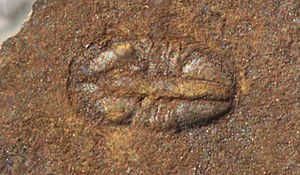Pagetia facts for kids
Quick facts for kids Pagetia |
|
|---|---|
 |
|
| A heavily eroded specimen of Pagetia taijiangensis, 6mm, from Kaili, Guizhou, China | |
| Scientific classification | |
| Kingdom: | |
| Phylum: | |
| Class: | |
| Order: |
Agnostida
|
| Suborder: |
Eodiscina
|
| Family: |
Pagetiidae
|
| Genus: |
Pagetia
Walcott, 1916
|
| species | |
|
|
| Synonyms | |
|
Eopagetia, Mesopagetia |
|
Pagetia is a small, ancient type of trilobite. Trilobites were a group of sea creatures that lived a very long time ago, during the Cambrian Period. Pagetia lived about 500 million years ago, during the Middle Cambrian time. These tiny animals were found all over the world, showing they were very widespread. There are about 55 different kinds, or species, of Pagetia that scientists know about today. Each kind lived in a specific place and for a certain period.
Contents
Discovering Pagetia Fossils
The first Pagetia was described by Charles Doolittle Walcott in 1916. This first species was named Pagetia bootes. It was found in the famous Burgess Shale fossil site. This site is in the Canadian Rocky Mountains in British Columbia, Canada.
Where Pagetia bootes Was Found
Pagetia bootes fossils come from a special place called the "greater phyllopod bed" in Walcott quarry. This area is near Wapta Mountain and Mount Field. The fossils found here help scientists understand what the world was like millions of years ago.
How Scientists Classify Pagetia
Scientists use a system called taxonomy to group living things. This helps them organize and understand different species. Pagetia belongs to the larger group of animals called Arthropods, which includes insects and crabs.
Pagetia in the Animal Kingdom
- Order: Agnostida
- Suborder: Eodiscina
- Family: Pagetiidae
- Genus: Pagetia
Species That Used to Be Pagetia
Sometimes, scientists learn new things and change how they classify animals. Here are some species that were once thought to be Pagetia but are now in different groups:
- P. attleborensis is now Hebediscus attleborensis
- P. jinnanensis is now Sinopagetia jinnanensis
- P. maladensis is now Macannaia maladensis
- P. medicinalis (a plant) is now Bosistoa medicinalis
- P. monostylis (a plant) is also now Bosistoa medicinalis
What Pagetia Looked Like
Pagetia was a small trilobite. It had some special features that helped scientists tell it apart from other similar trilobites.
Body Features of Pagetia
- Eyes: Unlike some other small trilobites, Pagetia had eyes.
- Facial Sutures: It had special lines on its head called proparian facial sutures. These lines helped the trilobite shed its old shell as it grew.
- Glabella: The glabella is the raised part in the middle of its head. In Pagetia bootes, this part tapered slightly forward and had a spine pointing backward.
- Front Border: The front edge of its head had a wavy, or crenulated, pattern. This was common for many trilobites in its family.
- No Genal Spines: It did not have sharp spines on the sides of its head, which are called genal spines.
Thorax and Pygidium
- Thorax: Pagetia had a body made of two segments, like two body rings. These segments could bend, allowing the trilobite to roll up into a ball for protection.
- Pygidium: This is the tail section of the trilobite. It was well-defined and often had five rings. It usually ended in a noticeable spine pointing backward.
The Hypostome
The hypostome was a plate-like structure under the front part of the trilobite's head. It was like a mouthpart. Scientists study the hypostome to understand how different trilobites are related.
Pagetia's Ancient Habitat
Many Pagetia fossils have been found in the Burgess Shale. This suggests they lived in the ancient seas that covered that area.
Living with Other Sea Creatures
Scientists have found Pagetia remains inside the empty tubes of a type of ancient worm called Selkirkia. This shows that Pagetia shared its home with other sea creatures.

